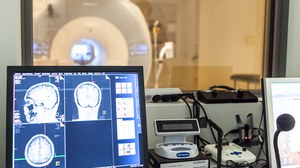Research
Human communication is probably the most important form of human interaction. Yet there are many people with communication deficits. For example, prevalence for person identity recognition deficits, developmental dyslexia or autism spectrum disorders range between 1%-10% of the population. Communication deficits can be socially restricting, and can lead to limitations in education and chances on the job market.
Research Topics
Our goal and research topics
The goal of our research group is to understand the neural mechanisms for communication in the healthy and neurotypically developed brain and to contribute to a better understanding of communication deficits such as developmental dyslexia and person identity recognition deficits. In our research programme we largely focus on two aspects of communication:
(i) Understanding what is said, i.e. speech recognition
(ii) Recognising who is talking, i.e. person identity recognition.
Our hypotheses
Communication signals are complex signals on fast time-scales, in multiple modalities, and have to be computed online, often under adverse conditions. In the past years we have shown that auditory and visual sensory processing interact much more and at earlier stages in the human brain than previously thought. These interactions might explain how the brain, in communication, can achieve its speed, accuracy, and robustness (e.g., von Kriegstein et al., 2008 PNAS; Blank et al., 2011 J Neurosci; Riedel et al., 2015 Cortex; Schall et al., 2013 Neuroimage). Auditory-visual interactions might also be beneficial for learning, e.g. when learning a new language or when getting to know a previously unknown person (von Kriegstein & Giraud, 2006 PLoS Biol ; Mayer et al., 2015 Curr Biol).
One of our current main hypotheses is that there are also much more and earlier within modality interactions, i.e. between cerebral cortex and the subcortical sensory pathways (von Kriegstein et al., 2008 Curr Biol; Diaz et al., 2018 Neuroimage). We expect that a dysfunction of such cortico-subcortical interactions can explain core features of developmental dyslexia (Diaz et al., 2012 PNAS; Müller-Axt et al. 2017 Curr Biol).
Our experimental approach
To test our hypotheses, we perform experiments using a broad methodological approach (e.g., functional and structural MRI, MEG, tDCS, TMS, eye-tracking) and advanced analysis techniques (e.g., multivariate pattern analyse, probabilistic tracking, computational modelling). Our research involves different participant groups, that is healthy and neurotypical controls, as well as people with selective developmental or acquired deficits (dyslexia, autism spectrum disorders, person identity recognition deficits).
References
Blank, Anwander, von Kriegstein (2011). The Journal of Neuroscience 31(36):12906-12915. Direct structural connections between voice- and face-recognition areas
Díaz, Blank, von Kriegstein (2018). Neuroimage 178, 721–734. Top-down modulation of the visual sensory thalamus assists visual-speech recognition
Diaz, Hintz, Kiebel, von Kriegstein (2012). Proceedings of the National Academy of Sciences of the United States of America 109(34):13841-13846. Dysfunction of the auditory thalamus in developmental dyslexia
Mayer, Yildiz, Macedonia, von Kriegstein (2015). Current Biology 25(4):530-535. Visual and motor cortices differentially support the translation of foreign language words
Müller-Axt, Anwander, von Kriegstein (2017). Current Biology 27:3692-3698.e4. Altered Structural Connectivity of the Left Visual Thalamus in Developmental Dyslexia
Riedel, Ragert, Schelinski, Kiebel, von Kriegstein (2015). Cortex 68:86-99. Visual face-movement sensitive cortex is relevant for auditory-only speech recognition
Schall, Kiebel, Maess, von Kriegstein (2013). NeuroImage 77:237-245. Early auditory sensory processing of voices is facilitated by visual mechanisms
von Kriegstein et al. (2008). Current Biology 18(23):1855-1859. Task-Dependent Modulation of Medial Geniculate Body Is Behaviorally Relevant for Speech Recognition
von Kriegstein, Dogan, Grüter, Giraud, Kell, Grüter, Kleinschmidt, Kiebel (2008). Proceedings of the National Academy Sciences 105(18): 6747 – 6752. Simulation of talking faces in the human brain improves auditory speech recognition
von Kriegstein, Giraud (2006). PLoS Biol 4(10): e326. Implicit Multisensory Associations Influence Voice Recognition

